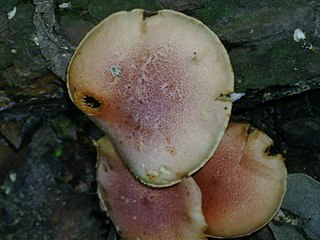
Gymnopilus junonius is a type of mushroom-forming fungus in the family Hymenogastraceae. Commonly known as the spectacular rustgill, this large orange mushroom is typically found growing on tree stumps, logs, or tree bases. Some subspecies of this mushroom contain the neurotoxic oligoisoprenoid gymnopilin.

Gymnopilus is a genus of gilled mushrooms within the fungal family Hymenogastraceae containing over 200 rusty-orange spored mushroom species.

Gymnopilus luteofolius, known as the yellow-gilled gymnopilus, is a large and widely distributed mushroom that grows in dense clusters on dead hardwoods and conifers. It grows in late July to November in the east and in the winter on the west coast of North America. It has a rusty orange spore print and a bitter taste.

Gymnopilus aeruginosus, also known as the magic blue gym, is a mushroom-forming fungus that grows in clusters on dead wood and wood chip mulch. It is widely distributed and common in the Pacific Northwest. It has a rusty orange spore print and a bitter taste and contains the psychedelic chemical psilocybin. It was given its current name by mycologist Rolf Singer in 1951.

Gymnopilus purpuratus is a species of agaric fungus in the family Hymenogastraceae. It grows in clusters on dead wood, tree stumps and wood chip mulch. It is widely distributed and has been recorded in Argentina, Australia, Chile, New Zealand, the UK and Germany. It has a broadly convex cap covered in small dry reddish-brown scales, a stout yellow stem beneath reddish brown, wine-red to purple vertical fibres, and a thick rusty orange spore print.

Gymnopilus sapineus, commonly known as the scaly rustgill or common and boring gymnopilus, is a small and widely distributed mushroom which grows in dense clusters on dead conifer wood. It has a rusty orange spore print and a bitter taste. This species does not stain blue and lacks the hallucinogen psilocybin.

Gymnopilus braendlei is a species of agaric fungus in the family Hymenogastraceae that contains the hallucinogens psilocybin and psilocin. It was originally described by mycologist Charles Horton Peck as Flammula braendlei, from specimens found in the District of Columbia in 1902.
Gymnopilus alpinus is a species of mushroom in the family Hymenogastraceae. It was given its current name by mycologist Rolf Singer in 1951.

Gymnopilus dilepis is a species of mushroom in the family Hymenogastraceae. This species is found in India, Malaysia, and North America. It was given its current name by mycologist Rolf Singer in 1951. It contains psilocybin and related hallucinogenic substances.
Gymnopilus hispidellus is a species of mushroom in the family Hymenogastraceae.
Gymnopilus medius is a species of mushroom in the family Hymenogastraceae.

Gymnopilus subpurpuratus is a species of mushroom in the family Hymenogastraceae. The type specimen was found in Jalisco, Mexico, growing on rotting pine wood in a garden. The fungus was described as new to science in 1991 by Gastón Guzmán and his daughter Laura Guzmán Dávalos.
Gymnopilus subearlei is a species of mushroom-forming fungus in the family Hymenogastraceae.
Gymnopilus rugulosus is a species of mushroom in the family Hymenogastraceae.

Gymnopilus imperialis is a species of mushroom in the family Hymenogastraceae. It was given its current name by mycologist Rolf Singer in 1951.

Gymnopilus lepidotus is a species of mushroom-forming fungus in the family Hymenogastraceae.
Gymnopilus nevadensis is a species of mushroom in the family Hymenogastraceae. The fungus was described as new to science in 1991 by Gastón Guzmán and his daughter Laura Guzmán Dávalos. The type collection was found in Jalisco, Mexico, where it was fruiting in a cluster on a dead branch in a pine and oak woodland.

Gymnopilus peliolepis is a species of mushroom in the family Hymenogastraceae. It was given its current name by mycologist Rolf Singer in 1951.











